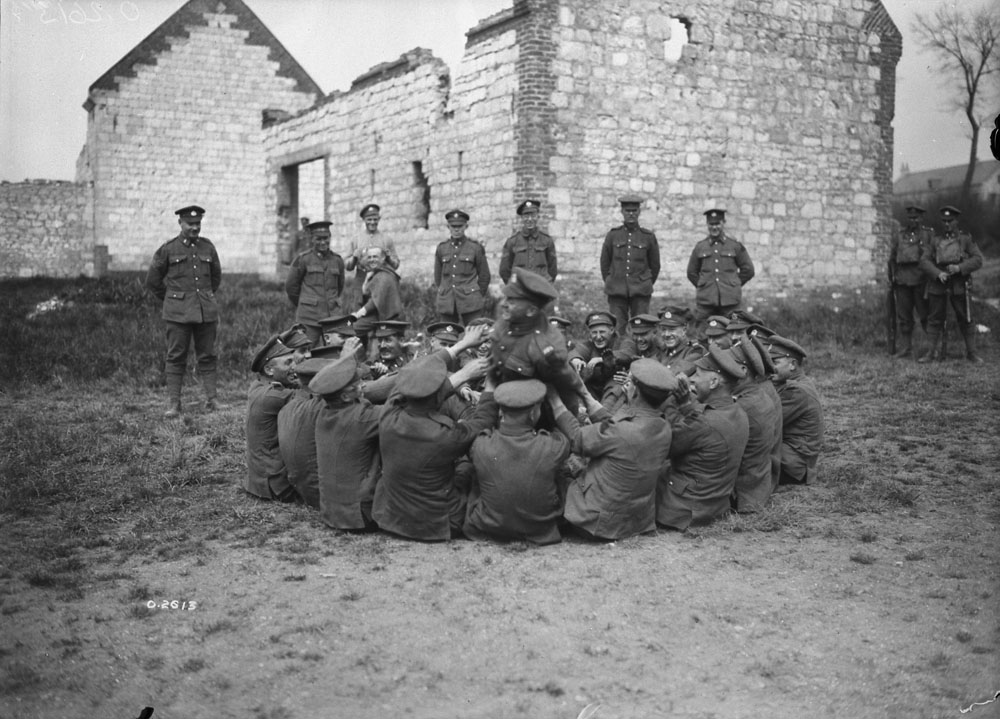Renwick William Hunter Anderson son of Burpee James and Mary Kerr Anderson, of Silton, Saskatchewan. Born 11 June 1893 in Assiniboia.

Renwick a farmer. The first student to register in the College of Agriculture of the University of Saskatchewan, obtaining his diploma in Spring of 1915.
Service of Renwick William Hunter Anderson
Private Renwick William Hunter Anderson 426240 attested 2 January 1915 at Regina with the 46th Battalion, CEF. Stood 5′ 8″ tall, with fair complexion, blue eyes and dark brown hair. He was Presbyterian.
Attached to 32nd Battalion, Shorncliffe, 19 July 1915. Then, a medical exam at Shorncliffe on 9 August 1915 by Lt.-Col. Cowan, Commanding 32nd Battalion. Renwick had re-signed his attestation, the original lost at the time. Uncharacteristically, forfeits 1 days pay, overstaying leave, 21 August 1915. Finally, transferred to 10th Battalion, 28 August 1915.
France
T.o.S., 10th Battalion, in France, 11 September 1915. Private Anderson immediately deployed to the Ypres Salient. The routine of war quickly sets in, a week in the forward trenches, followed by a week in Brigade Reserve, then a week in Divisional Reserve.
Private Anderson begins to feel the effects of Trench Foot in mid-October. Following several rotations in the nightmarish trenches, Renwick William Hunter Anderson admitted No.7 General Hospital, St. Omer, with measles, 27 November 1915. Transferred to No. 14 Stationary Hospital, Wimereux, 16 December 1915, where he also acquires influenza.
Return to England
Transferred to England, admitted to Military Hospital (debility), 29 December 1915. Discharged to Reserve unit, Shorncliffe, 5 January 1916. Though Renwick has simultaneously suffered from Trench Foot, measles, and influenza, doctors note he is strong mentally. Admitted once again for symptoms of Trench Foot, 29 February 1916.
At the CASC Stables, Private Anderson kicked by horse at the right knee, and admitted to Ward 3, Moore Barracks, Canadian Hospital, Shorncliffe, 4 August 1916. Accident witnessed by Private Peters, CASC. Renwick discharged three days later. Before the end of the year, Private Anderson promoted Acting Corporal.

Lieutenant Renwick William Hunter Anderson
Acting Corporal Anderson to be Temporary Lieutenant, 9th Reserve Battalion, 28 April 1917. Then, appointed to a Commission, Shorncliffe, 5 May 1917.

Anderson proceeds to a Rifle Course at Command School of Musketry, Thornhill, Aldershot, 22 May to 26 June 1917.

Return to France
Lieutenant Renwick William Hunter Anderson Taken-on-Strength as reinforcement from England, 10th Battalion, in the field, 24 December 1917. A grand welcoming awaits Renwick as he returns to his unit. Now, as an Officer, no less. The 10th Battalion in billets at Houdain, about to enjoy Christmas Dinner.

Renwick’s second tour of duty considerably longer than his first. Aided no doubt by his better health. Eight months pass, before he is Killed-in-Action, on the 50th day of Canada’s Last Hundred Days in the Great War.
Battle of Canal du Nord
At 5:30 p.m. the 10th Battalion passed through the 5th Battalion at Sunken Road, east of Haynecourt. Their right-flank became exposed, and they suffered direct infilade fire from machine guns, and field guns firing over open sights.
Reported from base, Lieutenant Renwick William Hunter Anderson, Killed-in-Action, 27 September 1918. While reconnoitering placement of a machine gun post, Lt. Anderson instantly killed by rifle fire. Buried at Sheet 51b.X.15.b.3.3 (the very eastern edge of Haynecourt, on Rue de Bourlon).
Haynecourt British Cemetery
Haynecourt is a village in the Department of the Nord approximately 6 kilometres north-west of Cambrai and 1 kilometre north of the main Arras to Cambrai road (D939). On 27 September 1918, the 1st Canadian and 11th Divisions took Haynecourt; and on the next day Sailly taken. Then, two cemeteries made by units which took part in the advance. Today, Haynecourt British Cemetery contains 289 Great War burials, eight of them unidentified.

Lieutenant Renwick William Hunter Anderson rests in Plot I. Row D. Grave20 in Haynecourt British Cemetery. Also commemorated on Page 359 of the First World War Book of Remembrance.
Niergnies Airport
Haynecourt, aerial photo by Royal Flying Corps, 13 August 1918 just prior to the construction of Haynecourt British Cemetery. Many casualties of the battle in the following month fell just east of Haynecourt, in the lower portion of the aerial image. Rue de Bourlon, and Sunken Road lead away from the village.

Niergnies Airport was a pre-Second World War civil airport servicing Cambrai. Seized by the German Army in May 1940 and used by Jagdgeschwader 3 (JG 3) flying Messerschmitt Bf 109Es. Then, the airfield bombed on 1st and 2d December 1943 with B-26 Marauder medium bombers (322d, 387th Bombardment Groups), damaging the facility beyond repair. The airfield not used again by the Germans. Then, on 10 September 1944, the IX Engineer Command 862d of the Engineer Aviation Battalion moved in and began a quick rehabilitation of the base. When the combat units moved out, Niergnies turned over to the French Air Ministry on 30 June 1945.
Haynecourt British Cemetery rests in the middle of a former NATO airbase.

Unused for the next five years, the air base at Cambrai-Niergnies offered to the USAF by the French Air Ministry as part of their NATO commitment. The base never fully utilized, other than the occasional touch-and-go landings of NATO aircraft, and when President Charles de Gaulle declared NATO could no longer store nuclear weapons on French soil, this base, and all other NATO bases in France closed permanently in 1967.
More
Please subscribe to CEFRG to be notified by email when there are new posts. Subscription is free, and your email kept confidential.

Comments
One response to “Lieutenant Renwick William Hunter Anderson in the Great War”
I want to thank you for posting this to share with others, the life we have today as Canadians is because of the people that fought for our country and helped others in need.